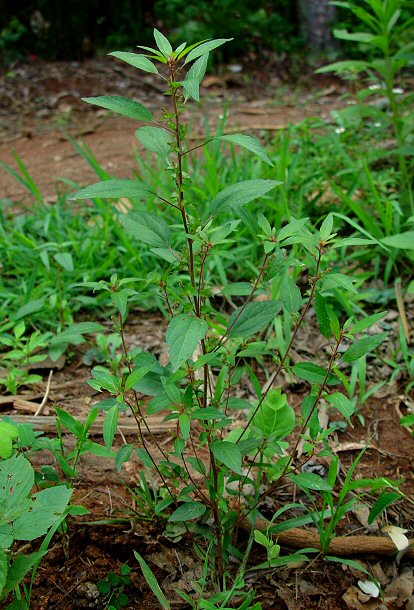Acalypha virginica L.
Virginia Copperleaf

Native
CC = 2
CW = 3
MOC = 82
© DETenaglia
Acalypha virginica L.Virginia Copperleaf | |
 |
Native CC = 2 CW = 3 MOC = 82 |
© DETenaglia |
|
Family - Euphorbiaceae Habit - Taprooted, monoecious, annual forb. Stems - Erect, to 60 cm, pubescent with short, strongly curved hairs, usually also with sparse to dense, longer, straight hairs. Sap clear. Leaves - Alternate, simple, petiolate. Petiole 1/4 to 1/2 as long as blade, longer than inflorescence bracts. Blades to 12 cm, lanceolate to ovate or rhombic, sharply pointed, the margins with blunt, shallow teeth, sometimes appearing shallowly scalloped, relatively thin-textured, the surfaces sparsely pubescent mostly along the veins with short, more or less appressed hairs. Inflorescences - Axillary spikes, 1-3 per node, each with 1-3 basal pistillate flowers below few to several nodes of staminate flower clusters.
Flowers - Inflorescence bracts to 20.0 mm, folded longitudinally around the inflorescence, with 10-15 triangular-ovate to broadly oblong lobes, hairy, rarely with sparse, minute, reddish, sessile glands.
Flowering - July - October. Habitat - Prairies, dry open woods, open valleys, moist or dry woodland, gravel bars, fallow fields, thickets, roadsides, railroads. Origin - Native to U.S. Other info. - This species can be found throughout Missouri and is quite common. It can be identified by the hairs on the stem (which are appressed AND spreading), the leaf petioles (which are less than 1/2 as long as the leaf blades), and the inflorescence bracts (which have many teeth). The leaf blades of this species vary from 8-40 mm broad. Photographs taken in Brown Summit, NC., 7-15-02. |